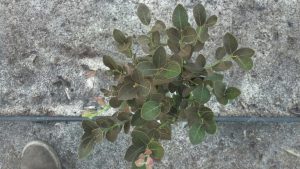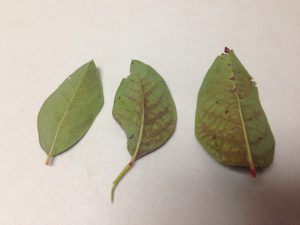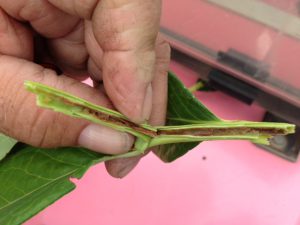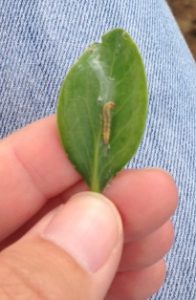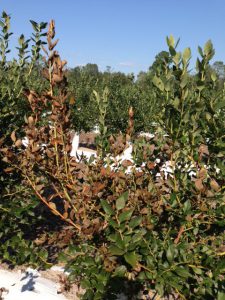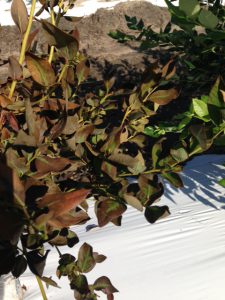Spider Mite Damage, more intense
Photo credit: James Jacobs, Pierce County Ag Agent
Earlier symptoms of spider mite damage
Photo credit: Renee Holland, Area Blueberry Agent
Recently, this damage has been spotted in highbush fields.
The leaves will have this finely speckled brown discoloration. Usually the presence of spider mites can be confirmed using a scope in your local UGA extension office. Keep in mind, this mite is a completely different mite than the one that is thought to transmit blueberry necrotic ring-blotch virus (funky spot).
In the case of spider mites, insecticides tend to actually exacerbate the situation, particularly pyrethroid materials. These mites like hot, dry climates. Try running your irrigation to keep fields from getting dry and dusty.
Flathead Stem Borer
A) Flathead borer symptoms B) Notice browning of tip and girdling of stem below
C) Characteristic brown “sawdust” symptom
Photo credit: Renee Holland, Area Blueberry Agent
I have spotted these blueberry flathead borer symptoms at multiple sites in Coffee county recently. What happens is some of the stems will appear to be drought stressed, wilting over at the top. More than likely this will not be affecting every stem, which is why you should question whether the root cause of this symptom is simply because of lack of water. Initially, stem tissue will be green, however, as the insect continues to damage tissue in the stem, the tissue at the tip of the stem will start to turn brown (photos A & B above). If you look closely at the stem, you will see what appears to be dehydration of the stem and some streaky brown discoloration (photo B). Damage from the insect has caused the stem to girdle which can cut off water and nutrient supply to the top of the stem. So yes, the stem is dehydrated, however, the root cause of the problem is the insect. If you cut open the stem, you should be able to see the brown “sawdust” symptom. The affected fields I observed this year so far have shown symptoms of excessive nitrogen use. The forthcoming flushes of luscious, tender green growth tend to attract “critters,” particularly insect pests and disease-causing fungi. The first defense against this pest is a healthy field with limited stress factors, such as drought, mechanical damage, etc., but if there are heavy infestations of this borer, an imidacloprid insecticide is recommended.
For more information, refer to Dr. Ash Sial’s September 2, 2014 blueberry blog post.
Obliquebanded Leafroller
Photo credit: Renee Holland, Area Blueberry Agent
Try to go out in your fields and unroll some leaves. You may be able to find this insect. Often, leaves on the tip of a stem will appear brown and rolled up, but if you unroll it, you may find this obliquebanded leafroller. Unless infestations are heavy, sprays are not typically warranted, particularly this time of year. It would be good to know whether you have a population in your field or not so that you can consider this pest, when you make an insecticide application in the spring or pre-harvest.
For more information on this pest, there are multiple resources online:
https://whatcom.wsu.edu/ipm/manual/blue/leafroller.html
https://msue.anr.msu.edu/uploads/files/Obliquebanded%20leafroller.pdf
Botryosphaeria Stem Blight & Fall Disease Management Reminders
A) Brown blighted shoots on blueberry plant affected by Botryosphaeria stem blight disease
B) Close up of symptomatic leaves turning brown before shoot completely turns brown
I have seen these Botryosphaeria stem blight symptoms in multiple fields in multiple counties. The fungal organism (or complex of organisms rather) that cause this disease is common in the environment. The good news is that typically the plant has to be wounded or stressed for disease to occur. For example, some of you may notice this in your Star fields because the plants may have been predisposed to the disease by wounding from mechanical harvesters. Herbicide burn on the base of a young, green shoot can provide an entryway for this pathogen. Be careful with young plants because they do not have lignified tissue (enough bark) at the base of the shoot yet. If you do not see a wound, then stress factors, such as drought or overuse of nitrogen, likely may have contributed to the onset of disease.
Multiple field trials have been conducted this summer looking more closely at this particular disease. Look for preliminary results at upcoming conferences and meetings.
The 2016 blueberry season is over here in Georgia, but there are still diseases to consider in the field. If you have Botryosphaeria stem blight disease moving through your field, a contact and systemic fungicide is recommended, for example Captan and Quash, Captan and Indar, etc. Hurricane Hermine brought significant rainfall and wind damage to many blueberry fields. Be on the look out for root rot symptoms which may appear as drought stress, yellowing and reddening of the leaves, and premature defoliation. Root rot fungicides, such as Prophyt, K-Phite, etc., may be needed after the incoming tropical depression. If possible, fall is a good time to blow out your rows, removing leaf and fallen fruit debris from underneath blueberry plants. Burying the debris in the row centers is recommended as a further step to reduce the mummy berry disease pathogen.
